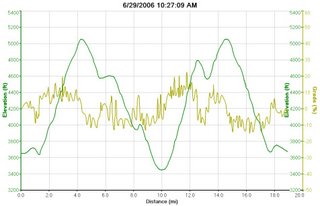Check out the backside on this Beech (Mtn)
On Memorial Day I climbed the front (south) side of Beech Mountain for the first time and wrote about it in an earlier blog entry. As best I can tell from the Garmin data I've gathered, the front-side climb is about 3 miles at an average grade of 9%. I felt pretty good about having made the climb but some of my thunder was stolen when I heard a rumor that the back (north) side of the mountain, while much less popular among cyclists, supposedly has a two mile stretch at an average grade of 12%. Ever since Memorial Day I've wanted to go back and confirm that rumor. Today, armed with a Garmin 305 and a PowerTap SL, I finally had the chance to do so.
I've attached a copy of the elevation/grade graph--complements of my Garmin 305--which shows me doing a loop up (front), down (backside), and back up (the backside) of the mountain. The front side (Highway 184) gains approximately 1425 feet in three miles. The back side has a two mile stretch (Pinnacle Ridge Road) that gains a whopping 1300 feet in 2 miles.
Because I had my PowerTap SL with me, I was able to measure my wattage for the climbs and compare my actual numbers with those predicted by this online velocity calculator. For example, I made the three mile front-side climb at an average speed of 7.4mph at 290 watts. I weigh about 170 pounds with kit and shoes on, my bike weighs about 21 pounds with water bottles. I plugged in 9% for the grade, 3000 feet for the elevation, and 75 degrees for the temperature. Sure enough, the calculater estimates an average speed of 7.4 mph! Amazing.
There is a 500 foot section of Pinnacle Ridge road that is *extremely* steep as you can see from the graph--as steep as anything I've ever attempted to climb. Using a combination of the PowerTap SL, my Garmin 305, and the velocity calculator, I was able to confirm that it averages 18% for that 500 foot section with one 200 foot spot that averages nearly 20%. Even at 350-400 watts I was really glad I had my triple with its 30-25 granny gear because my speed was only around 4.5 mph. At times I thought I might actually topple over sideways due to lack of speed. Unbelievable.
Anyway, pardon the geeky numbers. I thought it might be interesting to fellow Freds.

I've attached a copy of the elevation/grade graph--complements of my Garmin 305--which shows me doing a loop up (front), down (backside), and back up (the backside) of the mountain. The front side (Highway 184) gains approximately 1425 feet in three miles. The back side has a two mile stretch (Pinnacle Ridge Road) that gains a whopping 1300 feet in 2 miles.
Because I had my PowerTap SL with me, I was able to measure my wattage for the climbs and compare my actual numbers with those predicted by this online velocity calculator. For example, I made the three mile front-side climb at an average speed of 7.4mph at 290 watts. I weigh about 170 pounds with kit and shoes on, my bike weighs about 21 pounds with water bottles. I plugged in 9% for the grade, 3000 feet for the elevation, and 75 degrees for the temperature. Sure enough, the calculater estimates an average speed of 7.4 mph! Amazing.
There is a 500 foot section of Pinnacle Ridge road that is *extremely* steep as you can see from the graph--as steep as anything I've ever attempted to climb. Using a combination of the PowerTap SL, my Garmin 305, and the velocity calculator, I was able to confirm that it averages 18% for that 500 foot section with one 200 foot spot that averages nearly 20%. Even at 350-400 watts I was really glad I had my triple with its 30-25 granny gear because my speed was only around 4.5 mph. At times I thought I might actually topple over sideways due to lack of speed. Unbelievable.
Anyway, pardon the geeky numbers. I thought it might be interesting to fellow Freds.




